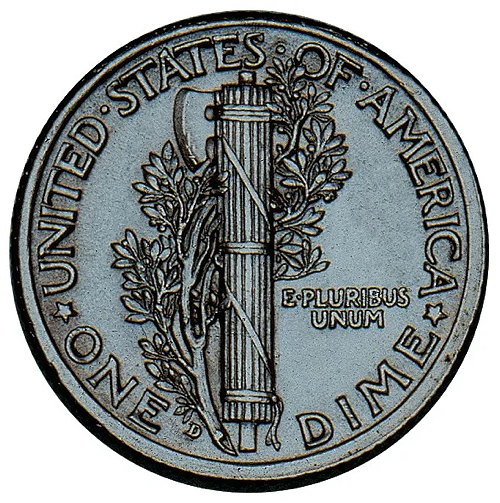America’s Fascist Dime
In 1916, the U.S. Mint introduced a dime that had, on one side, an image of the Fasces — a bundle of sticks that served as a symbol of authority in ancient Rome. The Fasces were also the source of the term 'fascism.' So as fascism emerged in Europe, it became increasingly awkward that the U.S. had a fascist symbol on its money. Finally, in 1945, the "fascist dime" was retired.

There have long been rumors that fascist supporters somehow managed to get the symbol on the dime. But mainstream opinion is that the presence of the symbol on the dime was just a weird accident. GovMint.com notes that Adolph Weinman had designed the dime in 1916, "three years BEFORE the Italian dictator Benito Mussolini adopted this symbol for his cruel regime."
Of course, it could have been worse. At least they didn't put a swastika on the dime.
More info: Numismatic News, Wikipedia

There have long been rumors that fascist supporters somehow managed to get the symbol on the dime. But mainstream opinion is that the presence of the symbol on the dime was just a weird accident. GovMint.com notes that Adolph Weinman had designed the dime in 1916, "three years BEFORE the Italian dictator Benito Mussolini adopted this symbol for his cruel regime."
Of course, it could have been worse. At least they didn't put a swastika on the dime.
More info: Numismatic News, Wikipedia
Comments
There is a pair of these flanking the Speaker of the House. As I recall, this is a symbol of industry or work. The axe bundled with sticks was how firewood was carried.
Posted by Kay Archer on 04/18/23 at 10:04 AM
The swastika, too, was a symbol - and a symbol of peace and wisdom - centuries before any Nazi was born. They're there in the original illustrations to Kipling's Just So Stories. (And yes, I do know that Kipling was a right-wing imperialist; but a Nazi or any other kind of fascist, he wasn't.)
Posted by Richard Bos on 04/22/23 at 09:32 AM
Richard Bos: Not really. The important difference is that the swastika looks as if it's spinning to the left, as specified by some guy named Adolf. The symbol of peace and wisdom spins to the right, and it is NOT a swastika. Some North American Indian tribes used it, for example. I guess it has many names, depending on the culture.
Posted by Virtual in Carnate on 04/23/23 at 11:25 AM
In the Lincoln Memorial, the statue of Lincoln is of him sitting on a chair fronted with fasces. As you noted, they represent strength and authority.
Posted by Curtis Hurley on 04/23/23 at 08:55 PM
An addendum to my prior comment. They are weapons (arrow shafts, e.g.) tied in a bundle. That they are bound indicates that they are not in use, in other words, a symbol of peace. Note the olive branches on the dime.
Posted by Curtis Hurley on 04/23/23 at 08:59 PM
My brother used to own a house built around the turn of the 20th century, long before Nazism. There were a few swastikas in the parquet floors. I don't remember which way they pointed.
Posted by ges on 04/23/23 at 10:43 PM
Apparently, "swastika" comes from Sanskrit and has the meaning as Richard Bos describes (for either version of the symbol). Mostly in India, the mirror image to the Nazi version is called "sauwastika". The meaning of this word vaies by culture.
Posted by Virtual in Carnate on 04/24/23 at 02:05 PM
@Virtual: eh, no. That's just the story Anglos tell themselves to convince their children that their grandparents weren't really Nazis. And they shouldn't, because they needn't, because all over the world for ages and ages both spins of the hooked cross, in all sorts and varieties, have been used as a symbol of life and good luck.
You're just giving in to Adolf, letting him steal the symbol that has always been all of ours. The myth that left is honourable and right is eeeeeeviiiilllll - or the other way 'round, I can't be bothered to tell - is just that: a myth. In reality, you will find all sorts all over the world.
@Curtis: yes, that as well. The Bundled Rod is also an ancient symbol, not specific to Rome. The one with an axe stuck in the middle was a national Roman symbol, but even then it had nothing to do with 20th century Fascism until the 20th century came along. Neither, for that matter, was the stretched-out-arm salute, which was used in the USA more than it was in ancient Rome - again, until the 1920s.
You're just giving in to Adolf, letting him steal the symbol that has always been all of ours. The myth that left is honourable and right is eeeeeeviiiilllll - or the other way 'round, I can't be bothered to tell - is just that: a myth. In reality, you will find all sorts all over the world.
@Curtis: yes, that as well. The Bundled Rod is also an ancient symbol, not specific to Rome. The one with an axe stuck in the middle was a national Roman symbol, but even then it had nothing to do with 20th century Fascism until the 20th century came along. Neither, for that matter, was the stretched-out-arm salute, which was used in the USA more than it was in ancient Rome - again, until the 1920s.
Posted by Richard Bos on 04/28/23 at 01:16 PM
Commenting is not available in this channel entry.

Category: Money